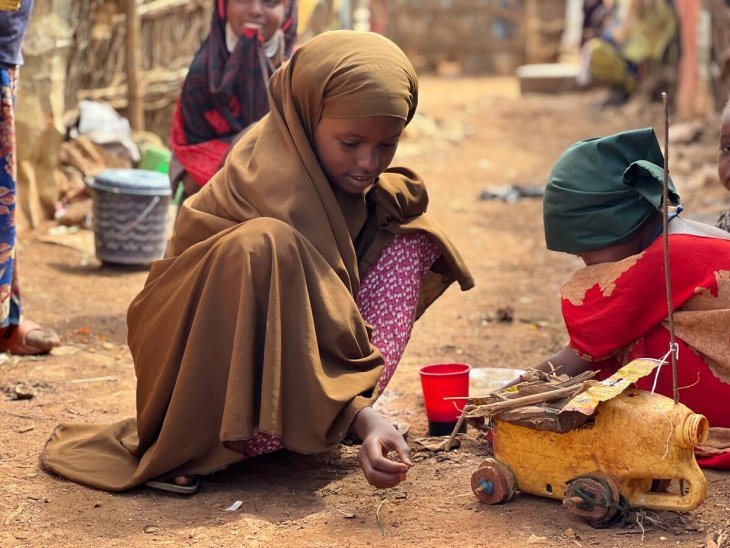The world is suffering from escalating levels of conflict. The Civil war in Ethiopia’s Tigray region, the Russian invasion of Ukraine, and the bombing of Gaza have all significantly contributed to dramatic increase in battle deaths in recent years.

Children in displacement camp in Somalia. Photo: Save the Children
Moreover, 2023 witnessed the highest number of state-based conflicts – 59 – since 1946. While armed conflicts affect people of all ages, children are especially vulnerable to the devastating consequences of war.
In addition to directly facing grave violations such as killing and maiming, recruitment by armed groups, sexual violence, abduction, attacks on schools and hospitals, and denial of humanitarian access, children also suffer more indirectly from the consequences of war. Children living in conflict-affected areas are more likely to drop out of school, lack access to clean water, and face heightened risks of death from illness, malnutrition, or lack of vaccines and medical care.
Today Save the Children launches its new report, Stop the War on Children 2024 Pathways to Peace.
The report is based on PRIO’s eighth annual mapping of children in armed conflict covering the period 1990–2023. Our latest estimates, covering the year of 2023, suggest that 473 million children, or more than 1 out of 6 of the world’s children were living in a conflict zone. Despite some fluctuations, there has been a steady increase over time: the share of the world’s child population living in conflict zones has almost doubled, from some 10% in the mid-1990s to almost 19% in 2023.
How we estimate the number of conflict-affected children
Most conflicts occur within limited, localized areas of countries. To estimate the number of children living in conflict zones, it is essential to isolate these areas. The UCDP Georeferenced Events Dataset (UCDP GED) provides precise data on the location of each separate conflict event or incidence of organized violence, including geographical coordinates. Using this data, we map circles with a 50 km radius around each conflict event and estimate the number of children residing within these areas based on population data from CIESIN and the UN. We define children affected by conflict as those living within 50 km of one or more conflict events. This 50 km radius is considered a reasonable distance within which conflict can significantly disrupt children’s daily lives.
Key findings from our 2023 update
- In 2023, approximately 1.9 billion of the world’s children lived in a conflict-affected country, and approximately 473 million – more than one in six children – lived in a conflict zone.
- Approximately 36% of all children exposed to conflict lived within 50 km of an area that experienced more than 25 battle deaths, and 56% lived in a high-intensity conflict country where there were 1,000 or more battle deaths.
- Regionally, the number of children living in conflict zones was highest in Africa (181 million), whereas the Middle East continued to have the highest share of children living in conflict zones relative to its child population in 2023 (32.1%).
Urgent need to protect conflict-affected children
Now, more than ever, the need to protect millions of children in conflict zones is both critical and urgent. Actors who work to address and reduce the impact of war on children should strive to:
- Promote systematic research on how armed conflict impacts children.
- Support effective peacekeeping in conflict zones.
- Prioritize children’s needs early in peace negotiations.
- Establish safe spaces for children in conflict areas.
- Enforce credible sanctions on armed groups to curb violations against children.
- Increase aid to rebuild infrastructure, especially education and healthcare, in conflict-affected countries.
For more information, read Save the Children’s full 2024 report, Stop the War on Children 2024: Pathways to Peace. Available at: resourcecentre.savethechildren.net/document/stop-the-war-on-children-pathways-to-peace/
For a policy brief describing our update of the annual mapping of children affected by armed conflict, read our PRIO Conflict Trends Policy Brief 0X/2023: ‘Children Affected by Armed Conflict, 1990–2023’.
- Gudrun Østby is a Research Professor at PRIO
- Siri Aas Rustad is a Research Professor and Research Director at PRIO